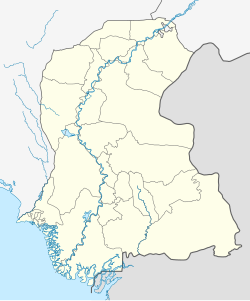| Pamwal Das Shiv Mandir | |
|---|---|
| Religion | |
| Affiliation | Hinduism |
| District | Karachi |
| Deity | Shiva |
| Location | |
| Location | Soldier Bazaar |
| State | Sindh |
| Country | |
| Geographic coordinates | 24°51′23.5″N66°59′52.8″E / 24.856528°N 66.998000°E |
| Architecture | |
| Type | Hindu temple architecture |
Pamwal Das Shiv Mandir at Pawaldass compound at Kakri Ground in Baghdadi area of Lyari Town. According to the Human Rights Commission of Pakistan and The News International, Muslim clerics have illegally turned this centuries-old historic temple into a Muslim pir and slaughterhouse for cows with the help of Baghdadi police after making series of attacks on Hindu families living in the area. [1] [2]



